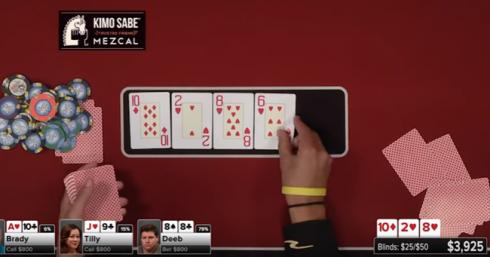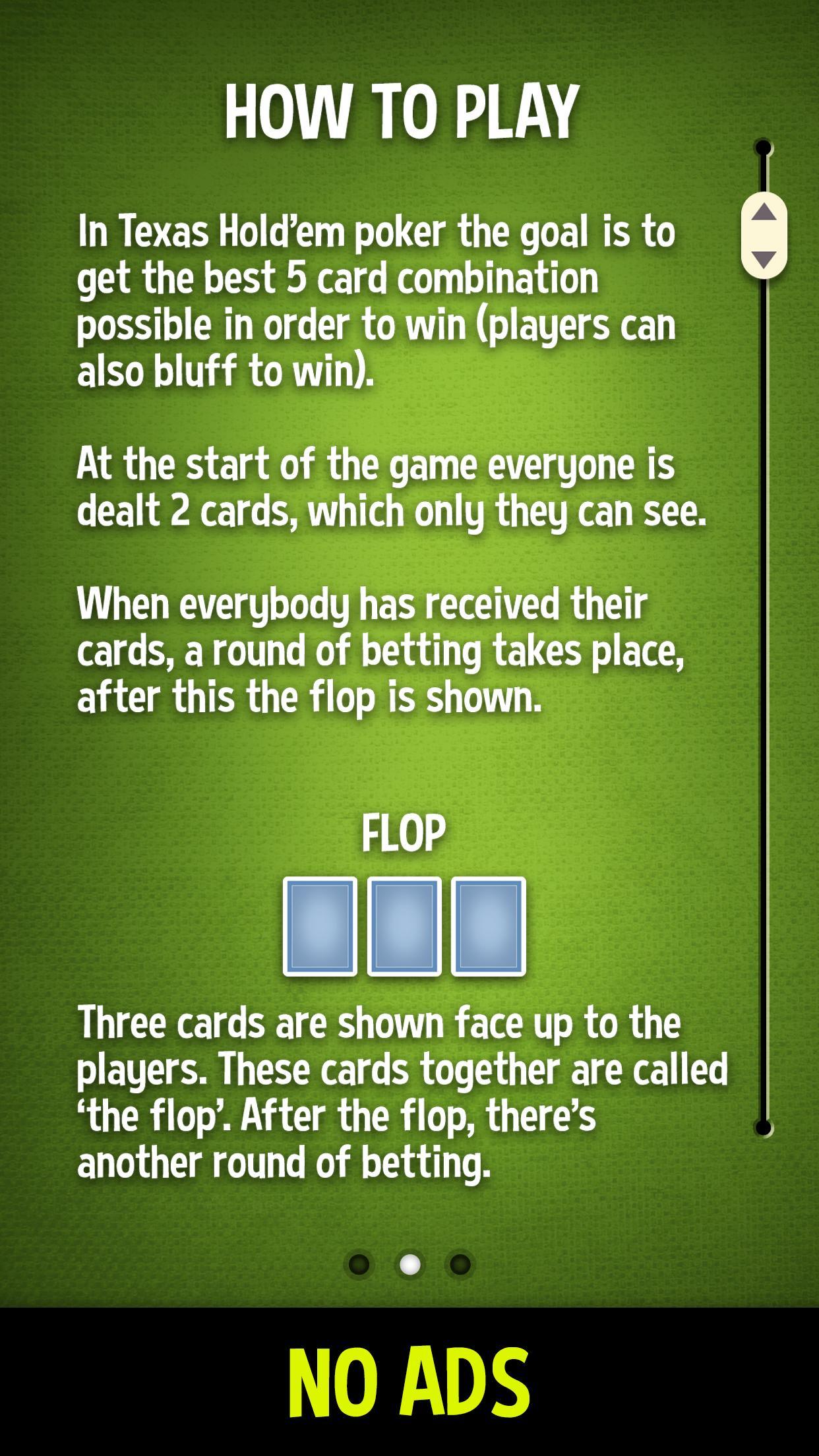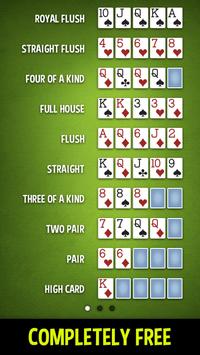An average Texas Hold’em player could expect to break even over a longer period. That is due to poker being a game with no innate house edge. However, rakes make it so that average and even slightly above average players are actually at a loss due to giving part of their winnings to the casino. Ways Online Casinos Make Money on Texas Hold’em. Texas Holdem Rules Your first task is to learn the rules of Texas Holdem. The game appears to be complicated because there are 4 rounds, each with a new card and opportunity to bet. But trust me, it’s not as complicated as you may think.
In our lesson on the three main betting variations of poker, we used an example where a player in a no-limit game could bet far more than anyone else at the table, provided the player had such an amount. Poker is always played at table stakes, and this means you can only wager the amount of money you have in front of you when the hand begins. It is quite common for a player to run out of money during a hand. If you have more money than another player, it doesn’t mean you can bet them out of the pot because they can’t afford to call your bet. Otherwise the poker player with the most money would always win if he bet all his chips, and it wouldn’t be a very enjoyable game.
All-in Bets
When a player puts all his chips into the pot he is said to be “all-in”. The important thing to know is that a player can never be bet out of a pot because he always has the option to call for all of his chips. For example, a player with $50 goes all-in, and everyone folds apart from a player who only has $30 left:
Figure 1
This player cannot match the $50 bet, but he can also go all-in for his last $30. When nobody else is involved, the first player would get back the unmatched $20 bet (i.e. his bet is $30 rather than $50). This is shown in figure 2, below:
Figure 2

In this example the shorter-stack wins the pot, but the surplus $20 is returned to player 5.
The whole point of this is that players can take back any extra money when another player is all-in for less, when nobody else has called. The same applies to an extreme no limit example, where a player might bet $10,000 in a $1/$2 game. Here’s an example where it’s folded around to the big blind, who has $10 remaining in his stack.
Figure 3

He has $12 in total and clearly can’t match the $10,000 – but he can go all-in. If he does then the player with $10,000, would take back $9,988. No more betting would take place, as there isn’t anything left to wager. After the flop, turn and river, the player with the best hand would win the $25 pot ($12 from each plus the small blinds $1).
Side Pots
It can be a little more complicated when there’s more than two players involved in a hand. This is when a side pot is created for the other players, and any further bets cannot be won by the all-in player. The all-in player is eligible for the main pot only.
Take a look at figure 4, below, which shows three players remaining in a hand. Two players have $50 each, and another has just $10 remaining. In this example the pot already contains $40 from the previous betting rounds. Player 5 makes a bet of $20:
Figure 4
Player 6 only has $10 but he can call for his last $10 (and would therefore be “all in”) or fold. If player 6 decides to go all-in for his last $10, then the last active player (player 7), who has $50, can call, but must call for $20, which is the original bet, or he can raise. If he calls then a side pot is created, as is shown in figure 5:
Figure 5
The main pot now contains $70, which is made up of the existing $40 in the pot, plus $10 x 3. Player 6 is “all in” and can only win this main pot. A side pot containing the extra $20 is created, and can only be won by the players who contributed to this side pot (players 5 and 7). The next card will be dealt and further betting will take place. Any further bets are added to this side pot, and not the main pot. Players 5 and 7, who contributed to the side pot, can win the side pot and the main pot, if their hand beats the “all in” player. If player 6 has the winning hand after the final betting round, then he will win the $70 pot, but the side pot will be won by either player 5 or player 7.
Conclusion
There has been quite a bit of information in this lesson, which to the uninitiated could be confusing. As soon as you start playing poker you’ll quickly become familiar with these betting basics because they occur very frequently. Sometimes there can be lots of different side pots during a hand involving lots of different players – whether it’s limit, pot limit, or no limit poker. This is because not everyone has the same amount of chips – and players who have fewer chips than an opponent cannot win more from a player than they contributed themselves. The important thing to remember is that a player can never be bet out of hand because he doesn’t have enough to call.
Related Lessons
By Tim Ryerson
Tim is from London, England and has been playing poker since the late 1990’s. He is the ‘Editor-in-Chief’ at Pokerology.com and is responsible for all the content on the website.
Related Lessons
How Does Texas Holdem Work In A Casino
| 1. | 888 poker | n/a | 888poker.com |
| 2. | PokerStars | n/a | PokerStars.com |
| 3. | Party Poker | PPAL500 | Partypoker.com |

Must be at least 18 to open a new account
This page describes the rules of Texas Holdem. However, the betting rules will vary depending on the type of Texas Holdem game you are playing. We will clarify the betting rules for No Limit Texas Holdem, Limit Texas Holdem, and Pot Limit Texas Holdem at the bottom of the page.
You can also watch this video that explains how to play Texas Holdem
Typically, you’ll find that online Holdem games are made up of 6 or 10 players per table, however it is possible to play Texas Holdem with any number of players, up to 10 per table. To start a new hand, a person is flagged as being ‘the dealer” (determined randomly online). The player immediately to the left of the dealer puts up a forced bet amount, called the “small blind” and the player to the left of the small blind posts the ‘big blind”. The small blind is always half the value of the big blind, and blind amounts are predetermined. The minimum bet you can make is always based on the value of the big blind. The rest of the players do not put up any money in the pot yet. Every time a new hand begins, the dealer button moves up to the next person at the table, which also means that the blinds move from player to player. Each player will eventually act as the big blind, small blind and dealer.
The Opening in Texas Holdem

Each player is dealt two cards face down, starting with the player in the small blind position. Obviously, you get to see your own two cards. The player in the dealer position will get dealt cards last. The first betting round now begins.
Betting Rounds in Texas Holdem
The player to the left of the big blind will be the first to act. He can call the bet by putting in the amount of the current bet, which is currently the value of the big blind. He can also raise by putting at least twice the amount of the current bet. The last option is to fold and withdraw from the hand.
The betting goes around the table in clockwise order, from player to player, until it reaches the player who posted the big blind, who did not yet act. If no one raised, the player can ‘check, which essentially means calling the current bet which he had already covered by posting his Big Blind amount. The player also has the option to raise. If a raise had already occurred, the player in the big blind could not ‘check” and would have to either call, raise or fold. The betting round continues around the table until the current bet is called by all remaining players in the hand, or until everyone but the raiser folds. In this case, this person would win the pot and wouldn’t even have to show their cards. The hand would be over and a new one would start. Assuming the bet was called, we proceed to the next step.
The Flop, turn and river
After the first betting round is completed, three cards are dealt and turned face up in the middle of the table. This is known as the “Flop”. These are community cards used by all the players. Another betting round begins with the first active player to the left of the dealer button. Since there are no bets currently, every player will have the option to “check” (which is the equivalent of betting $0 in this case), until an active player decides to bet an amount.
When the betting round after the flop is completed, the dealer turns a fourth card face up in the middle of the table. This is called the “Turn”. The third betting round now begins, and works just like the last betting round.
At this point, the dealer will turn a fifth and final card face up. This is called the “river,” and the final betting round can now begin.
The Showdown
Players have access to seven cards: Their two hole cards plus the 5 community cards on the board. To determine the winner, the players may use any combination of those seven cards to form the highest five-card hand. It is possible that your best hand is made up of the 5 board cards. There can occasionally be ties, in which case the pot is divided up amongst those who were tied. Otherwise, all of the chips in the pot go to the winner of the hand.
Texas Holdem Betting Rules
As indicated above, there are a total of four betting rounds. Betting takes place after the hole cards are dealt, after the flop, after the turn, and after the river. Below of the specific betting rules applicable the type of Holdem limit you are playing:
Texas Holdem World Series
Betting Rules for No Limit Texas Holdem
Texas Holdem Worst Starting Hands
The minimum bet amount is the value of the current bet. When there are not bets in play, the bet amount is the value of the big blind. For example, in a 5/10 table, where the small blind is $5 and the big blind is $10, you must raise to at least $20, assuming there were no other bets. There is no maximum raise amount, and you can bet your entire stack of chips, which is called going ‘all in”. Here is an example: Blinds are 10/20. Player 1 calls $20. Player 2 raises to $60. If someone else wants to raise, they must raise to at least $120 as the current bet is now $60. Calling means you put in a total of $60 so the big blind that already has $20 invested would need to add an additional $40 to call and stay in the hand. Folding means that he would lose the $20 already invested. Finally, anyone can go all in at anytime, even if they can’t cover the current bet. For instance, if the current bet is $400 and I only have $300 left, I can still call and be ‘all in”, but I can’t win more than $300 per player involved in the hand. For more information on how to deal with this situation, see this article on side pots in poker.
Betting Rules for Limit Texas Holdem
In Limit Texas Holdem a maximum of four bets is allowed per betting round. This includes an initial bet, a raise, a re-raise, and a cap (final raise). In limit Holdem, betting amounts are fixed, and are based on the big blind. So in a 10-20 limit game, the value of the big blind is actually $10 and not $20. So the small blind is $5, the big blind is $10. Out of the four Holdem betting rounds, the first two are based on the $10 increment, while the last two are based on the $20 increment. It may sound complicated, but it’s really not.
Here’s an example: In a $10/$20 limit game, blinds are 5 and 10. On the first betting round, the first person to act can call the $10, raise to $20, or fold. There are no other options. Typically, there can only be an initial bet and maximum of 3 raises in total, but that could vary in certain poker rooms. Once the maximum number of raises is attained, each remaining player must call or fold, but can no longer raise. The exact same thing happens on the second betting round. On the third and fourth betting rounds, everything works the same way with the exception that the bet amounts double, so calling begins at $20 and the initial raise is to $40. Additional raises are done in $20 increments.
Betting Rules for Pot Limit Texas Holdem
This works exactly as no limit Holdem, except that the maximum bet is caped. The cap is based on the total value of the pot, after you would call the bet. So for example in a $10/$20 pot limit game, after the blinds are posted, the first player can fold, call the $20, or raise to $50 which represents the total pot value had they called the bet. (small blind + big blind + call = 10+20+20). The next player can now fold, call $50, or raise up to $130 (small blind + big blind + the raise + call = 10+20+50+50). Now the next player can do the same and raise up to $340! (small blind + big blind + the raise + reraise +call = 10+20+50+130+130). You can go ‘all in” when your total chip count does not exceed the maximum raise allowed. So in the last example where $340 was the maximum raise, someone with $300 could go ‘all in”. Remember that you don’t necessarily have to raise up to the maximum amount if you don’t want to, but you must raise by as much as the current bet at least. While these amounts may be tricky to track, the software in poker rooms will let you know what the maximum betting amount is so you don’t have to worry about all the calculations.
How Betting Works Texas Holdem
Related Entries
Texas Holdem World Series Of Poker
Related posts:
